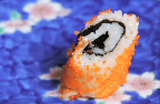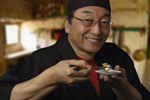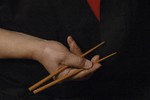
June 29, 2010: Akira Kurosawa’s “Dreams”
June 29, 2010 While my muse Yoshio is away leading a group around Japan, I’ve had to come up with other inspirations to explore Japanese food and culture on my own. It occurs to me that I have not yet reviewed one of my favorite Japanese films, that of Akira Kurosawa’s “Dreams” from 1990. If a culture reveals itself through its stories, and a person reveals himself through his dreams (really a story that one tells oneself) what better way to get a glimpse of a culture via a recounting of a person dreams, most particularly when that dreamer is one of the best film makers of not only a country but the world at large!
While my muse Yoshio is away leading a group around Japan, I’ve had to come up with other inspirations to explore Japanese food and culture on my own. It occurs to me that I have not yet reviewed one of my favorite Japanese films, that of Akira Kurosawa’s “Dreams” from 1990. If a culture reveals itself through its stories, and a person reveals himself through his dreams (really a story that one tells oneself) what better way to get a glimpse of a culture via a recounting of a person dreams, most particularly when that dreamer is one of the best film makers of not only a country but the world at large!
For that is exactly what “Dreams” is about: it is a retelling of dreams Kurosawa had, told chronologically, throughout his life. Kurosawa captures the flavor and the “language” of dreams: their pacing, weirdness, and use of symbol to try to make sense of our world (often through non-sense) and to reveal our concerns, fears, and ultimate wishes. Although I own this beautiful and telling film, I confess that I find I have to be in the mood for it, as it often moves slowly, capturing as it does the meditative effect that dreams have, rich in detail.
Sunshine Through the Rain: In this dream, Kurosawa is a boy who ventures out on a day that is raining, although the sun is shining. He is warned by his mother that he shouldn’t go out on such a day as the foxes celebrate their wedding ceremonies, and it is forbidden to view them. This only increases the boy’s desire to see such an event. Walking through a rainy and fog-filled redwood forest he finds a troop of magical “kitsune” or people-foxes parading through the forest in wedding procession. Trying to remain hidden, the boy is inevitably seen by the troop. Returning home, the boy is told by his mother that she was visited by a fox who told her that she cannot let him in. She then presents him with a blade and he is instructed to kill himself for his transgression. She tells him, they may forgive them, but he must find them first, where they live under a rainbow. This dream shows a childhood awe of magic, the fear of banishment from the hearth and home, and the lure of the unknown.
The Peach Orchard In this dream, Kurosawa is still a boy. He is serving his sister and her friends who are celebrating “Doll Festival.” He sees an “extra” girl who the others do not see. Following the girl outside, she leads him to the family’s destroyed peach orchard, where the “dolls” pictured earlier have come to life. The “dolls” say they are the spirits of the trees come back and admonish the boy for the orchard’s destruction. Kurosawa, as the boy, begins to cry and is further admonished by the ‘dolls” that he is crying because he will miss the peaches the grove supplied. When the boy says that he is crying because he will miss the orchard’s beauty at blossom time, the dolls grant him one last view of the orchard as he remembered it. When the vision subsides, he finds the “extra” girl has been turned into the only remaining tree left in the orchard. This dream explores themes of loss of childhood (and childhood memories), again the awe of magic, regeneration through our youth, and the mystic of the feminine world.
The Blizzard In this dream, Kurosawa is a young man, on a mountaineering trip through the Japanese Alps. The group of men are linked together and in dire straights: they are lost, fatigued, cold and desperate. Also, there is an approaching storm and if they cannot find their base, they are lost forever. To make things worse, in the middle of the storm, all his men fall asleep from exhaustion. Trying to revive them Kurosawa is confronted by a “snow fairy” who tries to lull him to sleep also, saying that ” The snow is warm. The ice is hot.” Shaking himself from her spell, the storm suddenly clears. In this dream, Kurosawa’s famous use of color is absent. There is only the blue of a cold world of ice and snow. He uses sound well in this story: for minutes at a time all that can be heard is the labored breathing of the men and the clank of equipment, followed by the roar of the storm that suddenly becomes quiet as the “snow fairy” sings. This dream explores man’s fear of nature as well as the “kami” (spirits) that inhabit it.
The Tunnel Kurosawa is an army commander returning home from the war. He comes upon a tunnel guarded by a fierce dog carrying hand grenades across it’s back (literally a “dog of war” or perhaps Cerberus, the guardian of the underworld.) Getting around the dog he passes through the tunnel. On the other side he hears a noise in the tunnel behind him and out steps the ghost of one of his former men. The ghost is trying to return home and as he cannot find his way, he pleads with his former commander to help him. The commander explains to the ghost that he has died and must return through he tunnel. The ghost reluctantly does, but soon returns with the rest of his platoon. The commander explains that it was through his error that the whole troop was annihilated, begs their forgiveness, and persuades them to return. As they recede down the tunnel the snarling figure of the dog returns. This dream explores the longing for home, fear of death, honor, guilt, and the futility of war.
Crows In this dream, Kurosawa is still a young man, a painter (that Kurosawa was before he broke into movies) that is visiting a museum showing the works of Van Gogh. Able to enter the world of the paintings the man goes off in search of Van Gogh himself. This is probably the least favorite dream in the series for most people due to two things: the digital effects of the “painting world” seem a little dated to modern viewers,( but remember this film was made 1990, really the birth of digital cinematography.) Also, the person playing Van Gogh…well..I don’t want to give it away, but I found it more humorous than distracting. This dream explores the passion for art, the drive to excel, hero-worship and our desire to be inspired.
I confess, I usually skip over the next two as I find these the most depressing as they deal with the threat of nuclear annihilation in Mt Fuji in Red and it’s after effects in The Weeping Demon. They are both worth a watch for first time viewers, as some people say that these are their favorites.
Village of the Watermills is perhaps my favorite of the lot. Kurosawa enters a peaceful and beautiful village that has a stream running though it, powering a series of watermills. He meets a very old man who is repairing one of the watermills. The old man describes his life in the village. The village has no electricity, no modern conveniences of any sort, yet the people remain very happy and live a long, full life due to their natural existence. The dream ends with a burial of the old man’s former lover. Instead of a solemn occasion, the whole village comes out with a happy parade, celebrating the woman’s life. Of course this dream represents an ideal of the way of life that a lot of us would want to live: free from the trappings of modern life and the stresses our modern “solutions” really end up making our lives more (not less as they were designed) complicated. Yes, an ideal…but a very beautiful one.






























Awesome blog….. I also like Kurosawa’s movies, he once said: “That time Japanese films all tend to be rather bland in flavor, like green tea over rice. I watched a woman read a book throughout the Japan home-grown movie. Japanese films have lost their youth, vigor and high aspiration. ”
I tried to write a blog about him, hope you like it: https://stenote.blogspot.com/2018/04/an-interview-with-akira.html